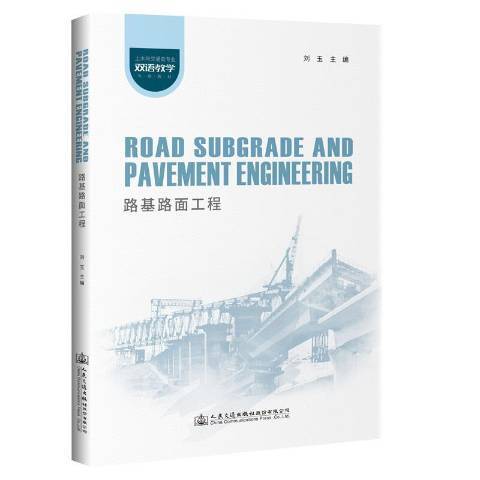《路基路面工程》是2020年人民交通出版社出版的圖書。
基本介紹
- 中文名:路基路面工程
- 作者:劉玉
- 出版時間:2020年
- 出版社:人民交通出版社
- ISBN:9787114145261
- 類別:工學類圖書
- 開本:16 開
- 裝幀:平裝

《路基路面工程》是2020年人民交通出版社出版的圖書。
路基路面工程課程是由李化東為課程負責人,長春建築學院為主要建設單位的國家級一流本科課程。教師團隊課程負責人:李化東授課教師:戴文亭、王會、李國棟、趙鶴松1所獲榮譽2020年11月24日,該課程被中華人民共和國教育部認定為...
《路基路面工程》是2018年8月1日武漢理工大學出版社出版的圖書,作者是盧珊珊、羅川。內容簡介 本書以最新的標準、規範為依據,以設計施工中實際套用的知識、技術為主要內容。全書分為三篇:路基工程、路面工程、路基路面施工技術,12個...
《路基路面工程 (第2版)》是2023年10月重慶大學出版社出版的圖書,作者:謝軍。出版信息 ISBN:978-7-5689-4182-2 高等學校土木工程本科指導性專業規範配套系列教材 作者:謝軍 編輯:夏雪 字數(千):736 頁數:435 印次:2-2 開...
《路基路面工程》是2014年清華大學出版社出版的圖書。內容簡介 目前全世界已有80多個國家和地區擁有高速公路,通車裡程超過了23萬km。高速公路成為當今社會不可或缺的公共基礎設施,路基路面工程是高速公路的基礎知識,馬立傑、王宇亮編著的《...
《路基路面工程(第四版)》是2014年人民交通出版社出版的圖書,作者是黃曉明。內容簡介 黃曉明主編的《路基路面工程(第4版)》為普通高等教育“十一五”規劃教材、精品課程建設核心教材。全書共分為十一章,主要內容包括:路基土的特性及...
《路基路面工程》是2018年機械工業出版社出版的圖書。內容簡介 本書依據“路基路面工程” 課程教學大綱, 參照我國道路工程的有關技術標準、規範, 結合套用型人才培養的要求編寫而成。內容著重介紹路基路面工程的基本理論和基礎知識, 各類...
《路基路面工程》是2019年南京大學出版社出版的圖書。內容簡介 《路基路面工程/高職高專“十三五”規劃教材·道路橋樑工程技術專業》圍繞高職院校交通土建類專業培養技術技能型人才的目標,將理論融於實踐,主要介紹路基路面工程的基本組成、...
《路基路面工程》是2021年北京大學出版社出版的圖書。內容簡介 《路基路面工程》內容全面新穎,算例詳細豐富,基本理論和方法講解透徹。全書共分為十章,總論、一般路基設計、路基邊坡穩定性分析、擋土牆設計、路基防護設計、軟體地基處理...
《路基路面工程》是2021年機械工業出版社出版的圖書。內容簡介 本書重點闡述路基路面工程的基本概念、基本原理和方法。本書在編寫過程中,力求融入*新的規範、標準和方法以及*新的科研成果,並將工程套用貫穿於其中,將科學性、前沿性和...
《路基路面工程》是2014年武漢大學出版社出版的圖書。內容簡介 《路基路面工程/普通高等學校土木工程專業精編系列規劃教材》是普通高等學校土木工程專業精編系列規劃教材之一。《路基路面工程/普通高等學校土木工程專業精編系列規劃教材》嚴格按照...
《路基路面工程》是2008年西南交通大學出版社出版的圖書,作者是田國芝,郭超祥。內容簡介 本書為21世紀高等職業技術教育道路與橋樑工程類規劃教材之一。全書分為兩篇:篇為路基工程,較系統地介紹了路基的基本內容、一般路基及特殊路基...
《路基路面工程》是2014年華南理工大學出版社出版的圖書。內容簡介 《路基路面工程/高職高專土建專業套用型“十二五”規劃教材》共十四章,內容涵蓋了路基和路面兩部分內容。主要講授路基工程概論、一般路基設計、路基邊坡穩定性設計、路基排水...
《路基路面工程》是2012年黃河水利出版社出版的圖書,作者是周娟。內容簡介 《道路與橋樑專業“十一五”高職高專套用型規劃教材:路基路面工程(第2版)》主要講授路基工程概論、一般路基設計、路基邊坡穩定性設計、路基排水設計、路基防護與...
《路基路面工程(第二版)》是2009年人民交通出版社出版的圖書,作者是李素梅。本書講述了路基工程和路面工程,路基路面的設計理論、施工方法、施工質量檢測內容和要求,對於路基路面的施工和質量檢測等作了論述。內容簡介 為了確保路基的...
《路基路面工程》是2020年人民交通出版社出版的圖書。內容簡介 With the rapid development of China ’s globalization, improving English communication skills has become increasingly important nowadays. The first step to enhance ...
《路基路面工程(第二版)》是2019年人民交通出版社出版的圖書,作者是宋金華,董鵬,馬立傑。本書是根據我國新頒布的有關路基路面工程的技術標準和規範、規程及實施細則,且吸收近年來取得的新科技成果編寫而成。內容簡介 本教材是根據...
《路基路面工程》是2005年科學出版社出版的圖書,作者是鐘陽。內容簡介 本書分為15章,介紹了路面材料及其路用特性、瀝青路面設計結構及其水泥混凝土路面設計、路基的濕度狀況及其路基的強度和穩定性等。圖書目錄 第一部分 路面工程前言 第...
路基路面工程課程是由黃曉明為課程負責人,東南大學為主要建設單位的國家級一流本科課程。教師團隊 課程負責人:黃曉明 授課教師:馬濤 所獲榮譽 2020年11月24日,該課程被中華人民共和國教育部認定為“首批國家級一流本科課程”。
《路基路面工程(第4版)》主要介紹路基路面設計、施工、管理等相關的基本概念、技術與方法。編者結合多年的教學與科研經驗,力求根據路基路面工程課程教學的基本環節及要求,著重介紹相關的基礎理論、基本概念、基本方法,使讀者通過本課程的...
《路基路面工程》是2009年科學出版社出版的圖書,作者是程培峰。內容簡介 本書分為路基工程和路面工程上、下兩篇,共十七章,內容包括:路基工程概論、路基設計、路基排水設計、水泥混凝土路面等。圖書目錄 上篇路基工程 第一章 總論 1.1...
路基路面工程(第二版)。圖書目錄 前輔文 篇 路基工程 第1章 路基的作用及基本要求 1.1 路基在道路工程中的作用 1.2 路基工程特點 1.3 對路基的基本要求 1.4 路基設計的基本內容 第2章 路基的力學特點及影響因素 2.1 路基...
《路基路面工程施工》是2020年武漢大學出版社出版的圖書,作者是石泉彬,韓振國。本書講授道路施工準備、路基土石方工程施工、路基排水及防護工程施工、路面基層施工、瀝青路面施工、水泥混凝土路面施工等內容。內容簡介 《路基路面工程施工(...
《路基路面工程(第二版)》是1999年同濟大學出版社出版的圖書,作者是陸鼎中。內容介紹 內 容 提 要 本書是根據我國最新頒布的有關道路工程的技術標準、規範,並吸收近幾年來 取得的科技成果,在《路基路面工程》(第一版)基礎上...
《路基路面工程(第2版)》是由沙愛民主編,高等教育出版社於2022年8月8日出版的新世紀土木工程系列教材,該教材可作為高等學校土木類、交通運輸類學科中公路工程、城市道路工程、市政工程、橋樑工程、隧道工程、機場工程、港口工程及其他...
《路基路面工程:道路·交通·市政》是2018年武漢大學出版社出版的圖書。內容簡介 路基路面工程是高等職業院校道路橋樑工程技術、市政工程技術等專業的必修課之一。路基工程和路面工程所屬的知識領域不盡相同,具有相對的獨立性。路基工程主要...
《路基路面工程(第2版)》是2016年3月1日中國電力出版社出版的書籍,作者是袁玉卿。內容簡介 全書共18章,包括路基路面的基本概念和基礎知識,路基穩定性、防護,擋土牆設計,路基排水,路基施工,路面結構類型,瀝青路面,水泥混凝土路面...
《路基路面工程》是2020年12月人民交通出版社出版的圖書,作者是劉玉。內容簡介 With the rapid development of China ’s globalization, improving English communication skills has become increasingly important nowadays. The first step ...
本書介紹路基路面工程的基本組成、材料要求、施工技術流程、質量控制標準。主要包括路基的基本組成、路面結構層組成與功能;路基路面工程常用材料的性能和技術要求;路基工程施工技術、路基(底)基層施工技術、瀝青類路面施工技術、水泥混凝土...
《高職高專土建類專業系列教材:路基路面工程》是2007年水利水電出版社出版的圖書,作者是田萬濤。內容簡介 《高職高專土建類專業系列教材:路基路面工程》是全國高職高專土建類專業系列教材。全書共18章,內容包括:緒論,穩定影響因素、...
《路基路面工程(第3版)》是2016年東南大學出版社出版的圖書,作者是黃曉明、李昶、馬濤。內容簡介 《路基路面工程(第3版)》分12章,主要介紹路基路面設計.施工、管理相關的基本概念、方法。內容包括一般路基設計、擋土牆設計、路基...
